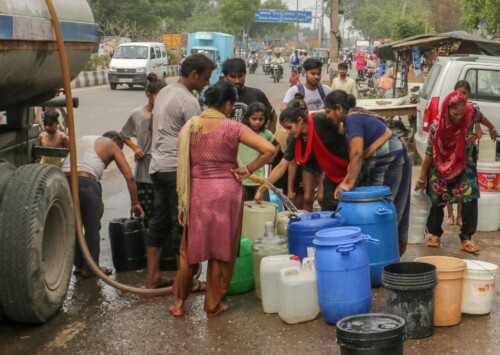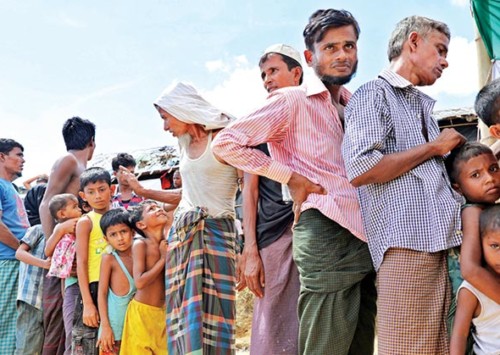50 pc of Earth’s rangelands degraded: UNCCD report

Rangelands which include natural grasslands, savannas, shrublands, wetlands, tundra, and deserts, constitute 54 pc of Earth’s land cover
A new report, Global Land Outlook Thematic Report on Rangelands and Pastoralists, by the United Nations Convention to Combat Desertificaction (UNCCD), released in Ulaanbaatar, Mongolia, has highlighted the alarming state of Earth’s rangelands, lands used for grazing animals and which are primary source of income for over 2 billion persons.
In a press statement, UNCCD says that half the rangelands are degraded and this jeopardises food security and ecosystems globally, as these lands account for one sixth of global food production and nearly one third of the planet’s carbon reservoirs.
The UNCCD says that rangelands, which include natural grasslands, savannas, shrublands, wetlands, tundra, and deserts, constitute 54 pc of Earth’s land cover.
“As custodian of the largest grasslands in Eurasia, Mongolia has always been cautious in transforming rangelands. Mongolian traditions are built on the appreciation of resource limits, which defined mobility as a strategy, established shared responsibilities over the land, and set limits in consumption. We hope this report helps focus attention on rangelands and their many enormous values – cultural, environmental, and economic which cannot be overstated. If these rangelands cannot support these massive numbers of people, what alternatives can they turn to,” says Bat-Erdene Bat Ulzii, Environment Minister of Mongolia.
The report says that Mongolia will host the 17th Conference of the Parties meeting in 2026, coinciding with the International Year of Rangelands and Pastoralists declared by the United Nations General Assembly at Mongolia’s initiative. The statement underscores the dependency of two billion people small-scale herders, ranchers, and farmers on healthy rangelands worldwide.
Livestock production employs 80 pc of the population in many West African states, while in Central Asia and Mongolia, 60 pc of the land area is utilised as grazing rangelands, supporting nearly one third of the region’s population, says report.
According to the report efforts to enhance food security and productivity by converting rangelands to crop production in mostly arid regions have led to degraded land and reduced agricultural yields. It highlights “weak and ineffective governance,” “poorly implemented policies and regulations,” and “the lack of investment in rangeland communities and sustainable production models” as factors undermining rangelands.
It adds that the past estimates of degraded rangeland worldwide, roughly 25 pc, significantly underestimate the actual loss of rangeland health and productivity, which could be as much as 50 pc.
The report says, rangelands serve as a vital economic engine in many countries and are integral to defining cultures. Hosting one quarter of the world’s languages, they also contain numerous World Heritage Sites and have shaped the value systems, customs, and identities of pastoralists for millennia.
The report provides detailed analyses of individual countries and regions, it adds that Brazil, with over 250 million cattle, produces 16 pc of the world’s beef, valued at USD 7.6 billion in 2019. In Europe, urbanisation, afforestation, and renewable energy production have replaced many rangelands. In the United States, large grassland areas have been converted to crops, while Canadian grasslands face fragility due to mining and infrastructure projects. Positive developments include efforts to reintroduce bison in both countries, promoting rangeland health and food security.
The report says that in Central Asia, China, and Mongolia, the shift from government management to privatisation and agricultural industrialisation has left herders abandoned, leading to widespread rangeland degradation. However, the gradual restoration of traditional and community-based pastoralism is enhancing sustainable rangeland management.
In North Africa and the Near East, climate change exacerbates poverty among pastoralists and degrades rangelands, but updated traditional institutions and supportive policies are improving rangeland management. In Sahel and West Africa, conflict disrupts livestock mobility, but unified policies and recognition of pastoralists’ rights are restoring mobility crucial for landscape restoration. In South America, climate change and deforestation drive rangeland degradation, but multifunctional pastoralist systems offer restoration opportunities.
It adds that in East Africa, land competition leads to pastoralists’ displacement, but women-led initiatives and improved land rights secure livelihoods and protect biodiversity. In North America, degradation threatens iconic ecosystems, but involving indigenous people in rangeland governance aids landscape recovery. In Europe, policies favour industrial farming, leading to rangeland abandonment, but political and economic support can mitigate environmental crises. In South Africa and Australia, afforestation and land conversion degrade rangelands, but co-creation of knowledge and respect for indigenous wisdom offer avenues for restoration and protection.
“When we cut down a forest, when we see a 100-year-old tree fall, it rightly evokes an emotional response in many of us. The conversion of ancient rangelands, on the other hand, happens in ‘silence’ and generates little public reaction,” says Ibrahim Thiaw, Executive Secretary, UNCCD.
“Sadly, these expansive landscapes and the pastoralists and livestock breeders who depend on them, are usually under-appreciated. Despite numbering an estimated half a billion individuals worldwide, pastoralist communities are frequently overlooked, lack a voice in policy-making that directly affects their livelihoods, are marginalised, and are even often seen as outsiders in their own lands,” he adds.
The report says that halting the deterioration of rangelands necessitates a paradigm shift in management, spanning from grassroots to global levels. Achieving “land degradation neutrality” as outlined in Sustainable Development Goal 15.3 requires cross-border cooperation to balance healthy land for ecosystem services and food security.
It adds that pastoralists, with their generational expertise, should play a pivotal role in informing this process, from planning to governance. Solutions must be tailored to the diverse characteristics and dynamics of rangelands, ranging from arid to sub-humid environments in regions like West Africa, India, or South America. The report emphasises that traditional assessment methods often underestimate the economic contribution of rangelands and pastoralism, underscoring the need for the recommended innovative approach.











